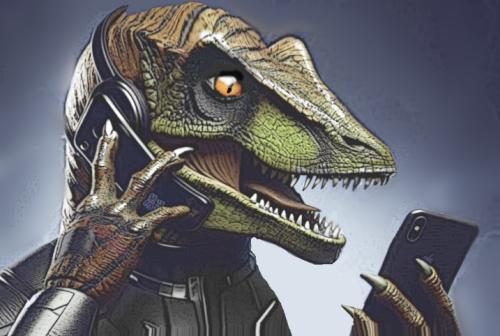BY LETTER
Lazurogen Angst
Culture and Society > Cultures and Sub-Cultures
Science > Paleontology
Science > Sophontology > Psychology
Science > Paleontology
Science > Sophontology > Psychology
 Image from Steve Bowers and Bing Image Creator | |
| Some lazurogens respond to angst by obsessive behaviour, paranoia and belief in conspiracy theories | |
As has been the case with virtually every form of presophont entity in the Terragen Sphere at one point or another, most lazurogen clades are almost inevitably subjected to subsequent provolution efforts, typically followed by attempts at socialization and integration into local societies and/or the greater Terragen Civilization. Very early on in the history of lazurogen provolution, it became apparent that the unique nature of lazurogens as recreations of extinct beings lent itself to a set of psychological traits, beliefs and behaviors that were generally not seen in other sophont clades. A well-known example of this is the cultural practice of "re-fossilization," observed by many clades of sophonts based on extinct animals from Earth's prehistory, in which an individual will voluntarily choose to undergo biological death and subsequent (natural or artificially accelerated) fossilization, maintaining consciousness all the while by instantiating their mind within a durable compubone skeleton. This practice stems from the fascination felt by many of these sophonts with their ancient "ancestors" and their own status as "resurrected" versions based on reconstructions of fossils, which is often associated with various metaphysical and spiritual beliefs.
In an unfortunately high fraction of cases, however, the unique nature of sophont lazurogens may also lead to various maladaptive or self-destructive thought patterns and behaviors. Many sophont lazurogens describe experiencing feelings of "inauthenticity" or existential inadequacy, generally stemming from contemplation of their ancestors/templates and noticing or suspecting that they themselves, or their immediate presophont lazurogen ancestors, are inaccurate copies of their extinct forebears. These feelings are more prevalent and intense in clades which bear obvious or significant physical differences from the current consensus reconstruction of their extinct template; these tend to be derived from earlier generations of lazurogens, which in many cases have less fidelity to their templates than newer generations, either as a result of technical limitations, not having had the benefit of subsequent advances in paleontological knowledge, or both. One of the most widely-known and academically interesting cases of the above is seen with provolves of the Late Cretaceous theropod Spinosaurus aegyptiacus<>, the reconstruction of which remained a subject of shockingly heated debate from the discovery of the species around 50 BT into well past the turn of the First Millennium AT, and which consequently gave rise to at least thirty-seven different anatomically-distinct attempts at lazurogenesis, fourteen of which have since been provolved.
Another common form of "lazurogen angst" involves various forms of ideation relating to a sense of "being outside the natural order of things," or existing despite nature/the universe having "willed" their nonexistence by virtue of allowing their predecessors to go extinct. In extreme cases, this may lead to psychosis, sometimes paired with suicidal behavior as the lazurogen sophont may come to the conclusion that they are a cosmic "error" that needs "correcting." The above thought patterns and associated behaviors are also commonly found in other types of sophont provolve clades, as well as in sophont neogens and splices, although in these cases they lack the added dimension of the sophont being a member of a "resurrected" clade.
A less serious but equally common delusion held by many sophont lazurogens is that they are, in fact, the direct resurrection or reincarnation of a specific individual from their extinct template clade. This belief is often triggered by the sophont noting similarities between their own features and the fossilized/otherwise preserved remains of a specimen from their "ancestral" clade. In the most extreme cases, the affected sophont may plead to be "de-evolved" and rendered presophont, out of a conviction that by physically and mentally mirroring their extinct counterpart as closely as possible, their consciousness will somehow jump the time gap between the past and present and transfer into the body of their long-dead likeness.
Society- or even civilization-wide instances of lazurogen angst are rare but not unheard of; several widely-publicized instances of mass bodyloss and/or permadeath throughout history have transpired as a more-or-less direct result of large-scale lazurogen angst. The destruction in 8453-8479 AT of a large swath of the Timekeeper habitat array in the Chronicle system was due in part to the actions of a disaffected minority of sophont lazurogen provolves based on a wide variety of extinct Terragen and xenobiont species, who chose to end their lives while simultaneously exacting "revenge" on the society that had (in their minds, wrongfully) brought them into existence.
The cosmopolitan but skittish and poorly-understood Neo-Cambrian Hider superclade commonly known as the Ghosts of the Cambrian appears to be another example of lazurogen angst on a societal scale; indeed, it is widely hypothesized that this is the unifying trait and central ethos of their "civilization," if in fact they represent a civilization at all.
Related Articles
- Anomalocaris
- Anomalocaroids
- Chronicle (System) - Text by Andrew P
Joint FAS-Negentropy Alliance system home to the famed Timekeeper Project, one of the largest and most comprehensive efforts to catalog, study and reconstruct extinct beings and civilizations from across time and space. Site of a tragic series of events in 8453-8479 AT wherein several billion sophonts underwent voluntary or involuntary bodyloss and/or permadeath due to the actions of a disaffected minority of sophont lazurogen provolves. - Ghosts of the Cambrian
- Lazurogenics
- Neo-Cambrians - Text by Andrew P
Any of various clades derived from neogenic or spliced "lazurogens" of extinct taxa from Earth's Cambrian Era; the paraphyletic superclade known as anomalocaroids (modeled on the predatory genus Anomalocaris) are among the oldest and most widely-known Neo-Cambrians. - Pseudolazurogen
- Spinosaurus aegyptiacus
Appears in Topics
Development Notes
Text by Andrew P.
Initially published on 27 September 2024.
Initially published on 27 September 2024.






